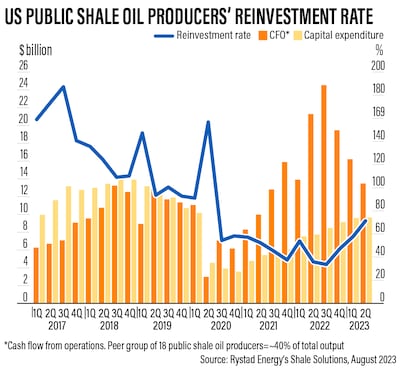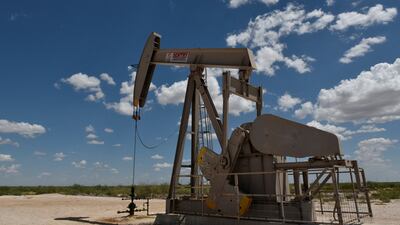US shale oil producers’ reinvestment rate hit a three-year high in the second quarter of 2023, Rystad Energy has said.
The Norway-based consultancy, which focused on a group of 18 public oil and gas companies in its analysis, said the reinvestment rate – the ratio between capital expenditure and cash flow from operations – stood at 72 per cent in the April to June months, the highest since the second quarter of 2020.
“At first glance, a rising reinvestment rate might point to a return to the old days of aggressive capital expenditure and rapid production growth,” said Matthew Bernstein, senior upstream analyst at Rystad Energy.
“However, discipline is the name of the game for public shale companies now, which ensures this trend will not last. As inflationary pressures ease in the coming quarters and oil prices rebound, this spike will be a short-term anomaly instead of a shift of strategy.”

A US shale resurgence, centred around the Permian Basin of Texas and New Mexico, turned the country into the world’s largest crude producer in 2018.
However, production growth has slowed in the past few years due to ageing wells, high inflation and growing investor demands.
Shale oil production is projected to drop to 9.41 million barrels per day in September, according to the US Energy Information Administration.
It touched a record high of 9.45 million bpd in July.
In the early stages of the shale revolution, reinvestment rates often exceeded 100 per cent and served as a clear indicator of the industry’s willingness to spend freely and expand volumes, Rystad said.
“However, in the current era of capital discipline, public shale companies prioritise shareholder value and exercise caution over a gung-ho investment strategy. As a result, the reinvestment rate only tells part of the story,” the consultancy said.
Inflation, which has pushed up drilling and completion costs, is contributing to a rise in capital expenditure while muted oil prices are dampening cash flow.
The total capital expenditure of oil and gas producers has increased for 10 straight quarters, reaching $9.7 billion in the second quarter of this year, from $7.8 billion in the same period in 2022, the report said.
Meanwhile, cash flow from operations fell to $13.5 billion as it continued its steady decline since the third quarter of 2022, when it peaked at $24.6 billion.
Even as inflation eases and oil prices tick higher on tight supply, Rystad has forecast falling reinvestment before 2024.
A vast majority of operators have spent more than 50 per cent of their guided 2023 budgets during the first two quarters, with several being left with only 45 per cent or less to invest, the consultancy said.
Earnings before interest, tax, depreciation and amortisation (ebitda) fell by about half from its peak of $30.7 billion a year ago, while headline net income dropped for the third straight quarter, Rystad said.
Although shareholder pay-outs declined in the second quarter, the ratio of returns to capital expenditure was still “extremely high” in a historical context, the report said.
Dividends as a ratio to capital spending stood at 28 per cent in the second quarter, down from a high of 75 per cent in the third quarter of 2022.
Stock buybacks fell to $1.7 billion, equal to 17 per cent of oil producers' capital spending during the period.
“Investors have grown used to the previously unthinkable level of cash returns being provided by operators, a centrepiece of the rebranded public shale business model,” Rystad said.
“Yet, they have also been generally understanding of the market conditions that have thus far inhibited further cash generation, and thus pay-outs.”
“As many operators have bound themselves to cash return pledges and issued modest guidance for organic growth, investors have largely aligned their expectations to market conditions.”
Brent crude, the benchmark for two thirds of the world’s oil, surged to about $140 a barrel after Russia’s invasion of Ukraine last year.
The benchmark has since given up most of its gains and is currently at about $84 a barrel, although Opec+ supply cuts and rising crude demand in China are expected to drive prices higher this year.

